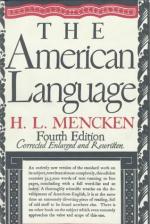
|
| Name: _________________________ | Period: ___________________ |
This test consists of 15 multiple choice questions and 5 short answer questions.
Multiple Choice Questions
1. How many works does Mencken claim to have discovered covering the topic of American slang?
(a) One.
(b) Twelve.
(c) Hundreds.
(d) Three.
2. According to Chapter 8.4, what is the first impulse behind American imitation of English orthography?
(a) Affectation.
(b) Compromise for cheaper printing.
(c) Anti-colonialism.
(d) Convenience.
3. How many soldiers' names were presented to the House by Mr. Mondell in 1919?
(a) 43.
(b) 102.
(c) 182.
(d) 27.
4. What leads most of the studies of the sounds of the American common speech astray, according to Mencken in Chapter 9.10?
(a) A lack of scope.
(b) Laziness.
(c) Individualistic interpretation.
(d) English conventionalism.
5. Which phrase did Oliver Wendell Holmes use to describe the state of the person who makes use of slang?
(a) Bumbling idiocy.
(b) Mental atrophy.
(c) Creative genius.
(d) Intellectual alacrity.
6. In what language does Mencken state the double negative was once "quite respectable?"
(a) French.
(b) Russian.
(c) Anglo-Saxon.
(d) Spanish.
7. What is the longest list of spelling changes from English to American that Mencken gives in Chapter 8.1?
(a) The omission of a redundant -e.
(b) The change of diphthongs into plain words.
(c) The -or/-our distinction.
(d) Miscellaneous differences.
8. In what century did England replace the "i-sound" with the "oi-sound" in words such as "boy"?
(a) The sixteenth.
(b) The eighteenth.
(c) The seventeenth.
(d) The nineteenth.
9. What principle of spelling was behind much of Webster's theory concerning the simplification of spelling?
(a) Flexibility.
(b) Vowel accentuation.
(c) Convention.
(d) Phonetics.
10. According to Mencken, Italians often take the names of what nationality when they marry?
(a) German.
(b) Irish.
(c) French.
(d) English.
11. What is the English equivalent of the American Main Street?
(a) Broad Street.
(b) High Street.
(c) Prime Street.
(d) King's Street.
12. What was the common, popular American slang word used for Germans during the First World War, according to Mencken?
(a) Kraut.
(b) Jerry.
(c) Hun.
(d) Boche.
13. Who is apparently the first literary critic to point out the "enormous gap between the literate and unliterate American"?
(a) Francis Hackett.
(b) I.A. Richards.
(c) Rene Wellek.
(d) Allen Tate.
14. From what language is "gob" reputed to be derived in Chapter 11.2?
(a) Chinese.
(b) Japanese.
(c) Persian.
(d) Spanish.
15. In what location does Mencken say both the American and English orthographies flourish side by side?
(a) New England.
(b) Canada.
(c) Hong Kong.
(d) Australia.
Short Answer Questions
1. What language does the formalism of English grammarians come from?
2. Which of the following nations does Mencken not list as having more interesting war slang than the Americans during the Great War?
3. According to the "Vocabulary of the A.E.F.," what percentage of the American military vocabulary was at least somewhat indecent?
4. Which nationality does Mencken claim is most eager to Americanize the names of their children?
5. Which of the following is the analogate to which Mencken compares the slang words overused by the ignorant?
|
This section contains 436 words (approx. 2 pages at 300 words per page) |

|




